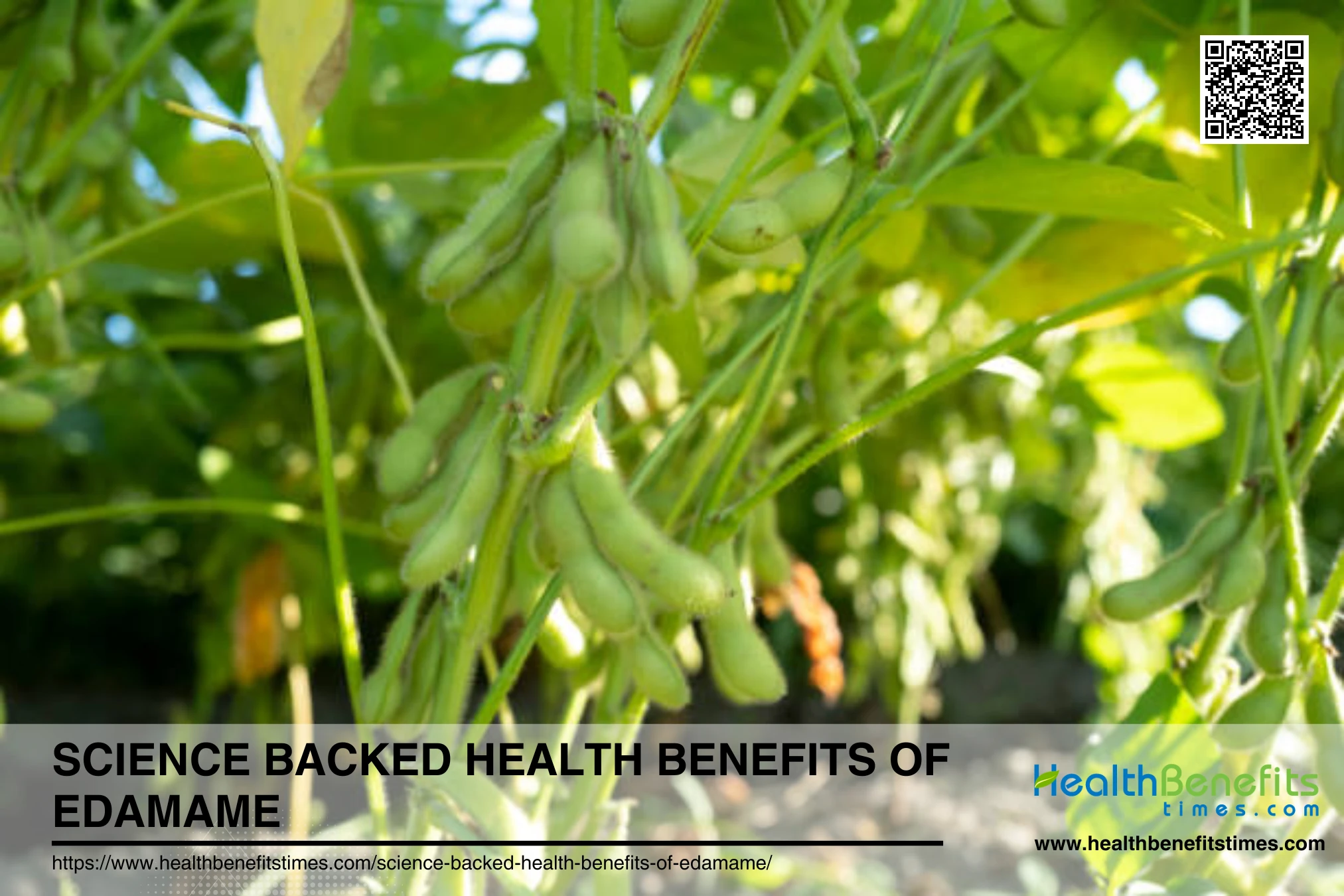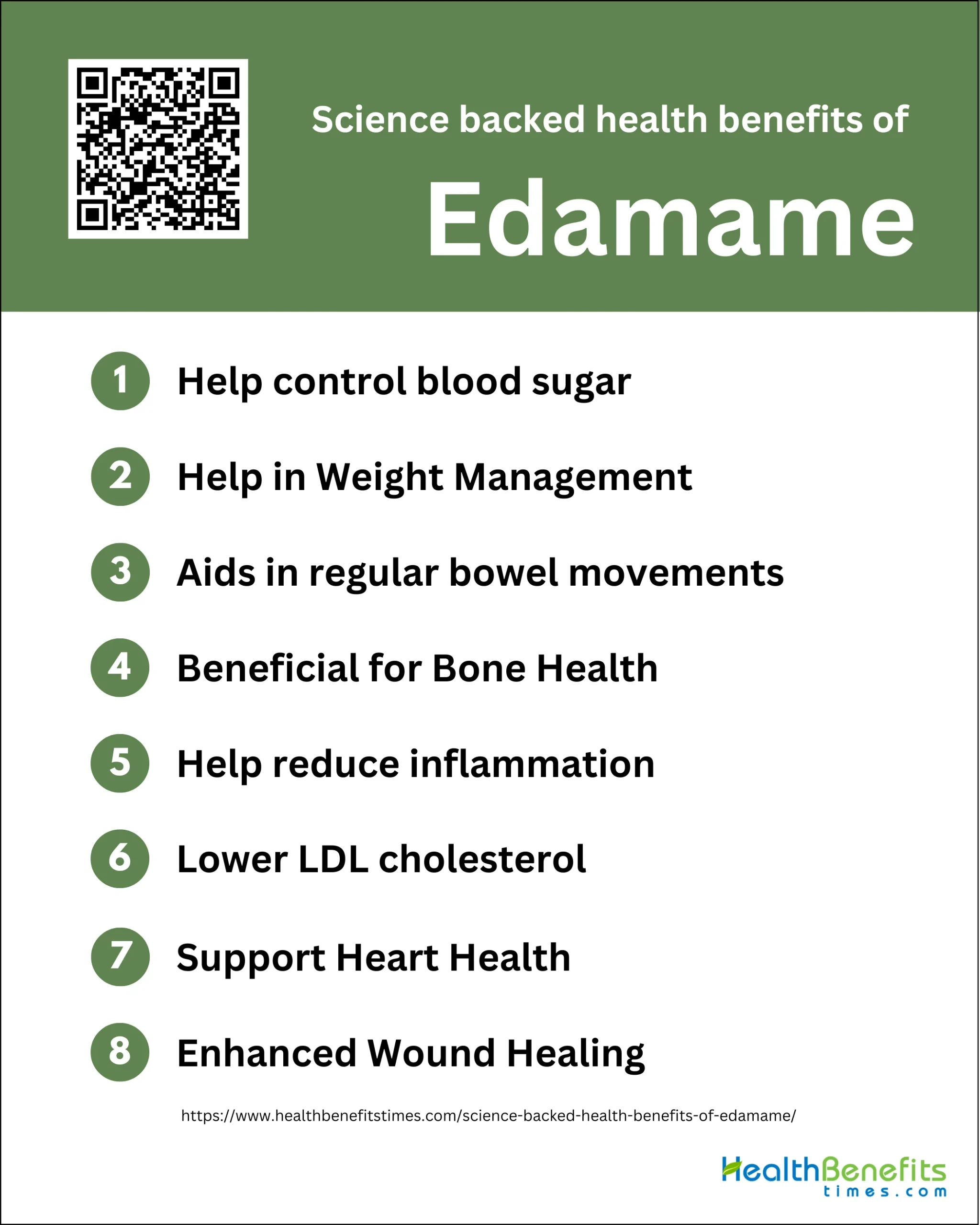- Edamame is a nutrient-rich, high-protein, low-calorie snack gaining U.S. popularity.
- Edamame varieties are Agate, Chiba Green, Butterbean, Midori Giant, Shirofumi, Kuroshinju, Tohya.
- Edamame is a nutritious, aids blood sugar control, weight management, and digestive health.
- Edamame supports bone health, reduces inflammation, lowers LDL cholesterol, enhances wound healing.
- Edamame is a versatile, nutritious, easy to prepare, enhances various dishes conveniently.
- Edamame is nutritious but excess causes digestive issues, hormonal imbalances, and allergies.
 Edamame, the young, green soybeans often enjoyed as a snack or side dish, are more than just a tasty treat—they’re a nutritional powerhouse backed by science. Rich in protein, fiber, vitamins, and minerals, edamame offers a plethora of health benefits that make it a worthy addition to any diet. Studies have shown that consuming edamame can help lower cholesterol, support heart health, and even reduce the risk of certain cancers. Additionally, its high protein content, including all nine essential amino acids, makes it an excellent choice for those following plant-based diets. Whether you’re looking to boost your nutrient intake or simply enjoy a healthy snack, the science-backed benefits of edamame are hard to ignore.
Edamame, the young, green soybeans often enjoyed as a snack or side dish, are more than just a tasty treat—they’re a nutritional powerhouse backed by science. Rich in protein, fiber, vitamins, and minerals, edamame offers a plethora of health benefits that make it a worthy addition to any diet. Studies have shown that consuming edamame can help lower cholesterol, support heart health, and even reduce the risk of certain cancers. Additionally, its high protein content, including all nine essential amino acids, makes it an excellent choice for those following plant-based diets. Whether you’re looking to boost your nutrient intake or simply enjoy a healthy snack, the science-backed benefits of edamame are hard to ignore.
What is Edamame?
Edamame, also known as vegetable soybeans (Glycine max), is a specialty crop harvested while still immature, typically at the R6 stage when the beans fill 80-90% of the pod cavity. This crop is rich in protein and other nutrients, making it a popular choice among health-conscious consumers. Traditionally consumed in East Asia, edamame is gaining popularity in the United States, where it is often enjoyed as a snack, lightly cooked in salted water, or added to salads, soups, and stir-fries. Despite its growing demand in the U.S., most edamame is still imported from Asia, prompting efforts to develop domestic varieties that meet consumer preferences and grow well in local conditions. Research has shown that factors such as planting location, genotype, and harvest timing significantly affect the quality and chemical composition of edamame, influencing attributes like sweetness, protein content, and overall acceptability. Additionally, consumer studies indicate a strong preference for domestically produced edamame, highlighting the potential for expanding U.S. production to meet this demand.
Nutritional Profile of Edamame
Edamame boasts an impressive nutritional profile that makes it a standout among plant-based foods. These young soybeans are packed with essential nutrients, including high-quality protein, dietary fiber, vitamins, and minerals. A single cup of cooked edamame provides around 18 grams of protein, 8 grams of fiber, and a variety of vitamins and minerals such as vitamin K, folate, iron, and magnesium. This nutrient density not only makes edamame a versatile addition to various dishes but also supports overall health and wellness.
High Protein Content
One of the most notable benefits of edamame is its high protein content. Unlike many plant-based foods, edamame contains all nine essential amino acids, making it a complete protein source. This is particularly beneficial for vegetarians and vegans who might struggle to meet their protein needs. With approximately 18 grams of protein per cup, edamame can help build and repair tissues, support muscle growth, and maintain a healthy immune system.
Rich in Vitamins and Minerals
Edamame is a treasure trove of essential vitamins and minerals that contribute to its numerous health benefits. It is particularly rich in vitamin K, folate, iron, and magnesium, each playing a crucial role in maintaining various bodily functions. These nutrients support everything from bone health and blood clotting to energy production and immune function. Incorporating edamame into your diet can help ensure you meet your daily nutritional requirements.
Vitamin K
Vitamin K is vital for blood clotting and bone health, and edamame is an excellent source of this essential nutrient. A single cup of cooked edamame provides about 41% of the recommended daily intake of vitamin K. This vitamin is crucial for producing proteins that help with blood coagulation and maintaining bone density, reducing the risk of fractures and osteoporosis.
Folate
Folate, also known as vitamin B9, is another key nutrient found in edamame. It is essential for DNA synthesis, cell division, and proper brain function. Pregnant women, in particular, need adequate folate to prevent neural tube defects in their developing babies. A cup of edamame offers roughly 121% of the daily recommended intake of folate, making it an excellent dietary choice for expecting mothers and anyone looking to support their overall health.
Iron
Iron is crucial for transporting oxygen throughout the body and supporting energy levels. Edamame provides a substantial amount of iron, with one cup delivering about 20% of the daily recommended intake. This makes it a great option for those who might be at risk of iron deficiency, such as vegetarians, vegans, and women of childbearing age. Including edamame in your diet can help prevent anemia and maintain optimal energy levels.
Magnesium
Magnesium is an essential mineral involved in over 300 biochemical reactions in the body, including muscle and nerve function, blood glucose control, and protein synthesis. Edamame is a good source of magnesium, providing around 20% of the daily recommended intake per cup. Adequate magnesium intake can help reduce the risk of chronic diseases such as heart disease and diabetes, making edamame a valuable addition to a balanced diet.
Low in Calories
Despite its rich nutritional profile, edamame is surprisingly low in calories, making it an ideal snack for those looking to manage their weight. A cup of cooked edamame contains only about 188 calories, yet it is highly satisfying due to its high protein and fiber content. This combination helps you feel full longer, reducing the likelihood of overeating and aiding in weight management efforts.
Types of Edamame
Based on the search results, here is a list of edamame varieties with individual paragraphs on each:
1. Agate
Agate is an heirloom edamame variety that was introduced to the United States in the 1920s. It is characterized by small, olive-green beans with brown saddles. This variety is well-suited for domestic cultivation and is known for its adaptability to various climates, making it a popular choice for home gardeners and small-scale farmers.
2. Chiba Green
Chiba Green is an early-ripening edamame variety that produces large, dark green pods. It is highly productive and known for its excellent flavor. As a bush bean variety, Chiba Green is relatively compact, making it suitable for smaller garden spaces. This variety has performed well in many U.S. regions and is often favored for its high percentage of pods containing three beans.
3. Butterbean
Butterbean is renowned as one of the tastiest edamame varieties available. It grows on small plants, making it ideal for gardens with limited space. This variety consistently produces pods with three beans, which is considered desirable for both yield and eating quality. Butterbean’s exceptional flavor makes it a favorite among edamame enthusiasts.
4. Midori Giant
Midori Giant is an early-maturing edamame variety that is prized for its reliability in producing pods with two to three beans. This characteristic makes it an excellent choice for those seeking a consistent and abundant harvest. Midori Giant’s early maturation also makes it suitable for regions with shorter growing seasons.
5. Shirofumi
Shirofumi is an heirloom variety originating from Japan and is considered one of the best soybean varieties for edamame production. It is known for its early maturation and heavy yields. The plants are typically loaded with pods, making it a favorite among gardeners and small-scale farmers looking for high productivity.
6. Kuroshinju
Also known as “Black Pearl,” Kuroshinju is a unique edamame variety with a black seed coat when fully mature. It is an heirloom variety that is prized for its silky texture and sweet flavor. Kuroshinju is also noted for its early maturation and high antioxidant content, making it an excellent choice for those seeking both flavor and nutritional benefits.
7. Tohya
Tohya is an edamame variety that has shown excellent performance in North American climates, particularly in regions like North Dakota. It is characterized by its early ripening, larger pod size, and more flavorful seeds compared to other early-maturing varieties. Tohya’s adaptability to cooler climates makes it a popular choice for gardeners in northern regions.
Science backed health benefits of Edamame
Edamame, the young, tender soybeans often found in Japanese cuisine, are not just a delicious snack but a nutritional powerhouse with numerous health benefits. Backed by scientific research, these vibrant green beans are packed with essential nutrients that can support overall health and well-being. From high-quality protein to vital vitamins and minerals, edamame offers a range of advantages that make it a valuable addition to any diet. In this article, we will explore the science-backed health benefits of edamame, shedding light on why these humble beans deserve a spot on your plate.
1. Help control blood sugar
Edamame can help control blood sugar levels, making it a beneficial food for individuals managing diabetes or looking to maintain stable blood glucose levels. These young soybeans have a low glycemic index, meaning they cause a slower, more gradual rise in blood sugar after consumption. This is largely due to their high fiber content, which slows the absorption of glucose into the bloodstream. Additionally, the protein in edamame helps to further stabilize blood sugar by promoting a slower digestion process. Studies have shown that incorporating high-fiber, low-glycemic foods like edamame into your diet can improve insulin sensitivity and reduce the risk of blood sugar spikes, contributing to better overall glycemic control.
What Research Says?
- Consumption of buffalo curd milk-edamame pudding snacks significantly reduced fasting blood glucose levels in Type 2 diabetes mellitus (T2DM) patients.
- Kaempferol glycosides from unripe soybean leaves (edamame) decreased fasting blood glucose levels in high-fat-diet mice.
- Edamame milk significantly reduced triglyceride levels in type 2 diabetes Wistar rats, with higher doses showing greater efficacy.
2. Help in Weight Management

Edamame can be a valuable ally in weight management due to its high protein and fiber content combined with its low calorie count. A single cup of cooked edamame contains about 188 calories, yet it is rich in nutrients that promote satiety and reduce overall calorie intake. The high protein content helps to curb hunger by increasing the levels of appetite-reducing hormones, while the dietary fiber slows digestion, keeping you feeling fuller for longer periods. This combination can help prevent overeating and reduce the likelihood of snacking on less healthy options. Additionally, the complex carbohydrates in edamame provide a steady source of energy without causing rapid spikes in blood sugar, further aiding in maintaining a healthy weight.
What Research Says?
- Incorporating edamame into the diet led to significant reductions in body weight, BMI, waist circumference, and sagittal abdominal depth in overweight and obese women over a 12-week period.
- Kaempferol glycosides from unripe edamame leaves reduced body weight, adipose tissue, and triglyceride levels in high-fat diet mice, suggesting potential anti-obesity effects.
- Ensiled edamame processing waste was consumed adequately by ewes, maintaining their body weight over a 17-day period, indicating that edamame can be a viable component of a balanced diet without adverse effects on intake or digestibility.
3. Aids in regular bowel movements
Edamame plays a significant role in promoting regular bowel movements and maintaining digestive health. This is primarily due to its high fiber content, with a single cup of cooked edamame providing approximately 8 grams of dietary fiber. Fiber is essential for proper digestion as it adds bulk to the stool, making it easier to pass through the intestines. The insoluble fiber in edamame helps prevent constipation by speeding up the movement of waste through the digestive tract, while the soluble fiber acts as a prebiotic, nourishing beneficial gut bacteria. This combination not only aids in regular bowel movements but also supports overall gut health, potentially reducing the risk of digestive disorders and promoting a healthy microbiome. Regular consumption of fiber-rich foods like edamame can lead to improved digestive function and a more comfortable, consistent bathroom routine.
What Research Says?
- Ensiled edamame soybean processing waste was consumed adequately by ewes, maintaining their body weights over 17 days, indicating good digestibility and intake, although this study focused on ruminants rather than humans.
4. Beneficial for Bone Health

Edamame is highly beneficial for bone health due to its rich content of essential nutrients that support bone density and strength. It is particularly high in calcium, magnesium, and vitamin K, all of which play crucial roles in maintaining healthy bones. Calcium is a fundamental component of bone tissue, while magnesium helps with the absorption and metabolism of calcium, ensuring that it is effectively utilized by the body. Vitamin K is vital for the production of osteocalcin, a protein that binds calcium to the bone matrix, enhancing bone mineralization. Additionally, the isoflavones in edamame have been shown to have a positive effect on bone health by mimicking estrogen, which helps to maintain bone density, especially in postmenopausal women. Regular consumption of edamame can thus contribute to stronger, healthier bones and may help prevent conditions like osteoporosis.
What Research Says?
- Foliar application of nano cattle bone ash combined with a reduced dose of SP-36 fertilizer significantly increased the pod yield of edamame soybeans by 21.7% compared to the control group. This suggests that nano cattle bone ash can enhance the growth and yield of edamame, potentially contributing to better nutrient profiles in the harvested beans.
5. Help reduce inflammation
One of the key components in edamame is isoflavones, which have been shown to possess anti-inflammatory properties. These compounds can help modulate the body’s inflammatory response, potentially reducing the risk of chronic inflammatory diseases such as heart disease, arthritis, and certain cancers. Additionally, edamame is a good source of omega-3 fatty acids, which are known for their ability to reduce inflammation in the body. The high fiber content in edamame also contributes to its anti-inflammatory effects by promoting a healthy gut microbiome, which plays a crucial role in regulating inflammation. Incorporating edamame into your diet can thus be an effective strategy for managing and reducing chronic inflammation, supporting overall health and well-being.
What Research Says?
- Genistein-rich edamame significantly reduces hs-CRP levels, a marker of inflammation, in atherosclerosis-induced rats compared to controls.
- Genistein in edamame has demonstrated anti-inflammatory, antibacterial, and antioxidant properties, which are beneficial in reducing oxidative stress and promoting healing in burn wounds.
6. Lower LDL cholesterol
Edamame is effective in lowering LDL cholesterol levels, which is crucial for heart health. The soy protein found in edamame has been extensively studied and shown to reduce levels of low-density lipoprotein (LDL) cholesterol, often referred to as “bad” cholesterol. This reduction occurs because soy protein can enhance the liver’s ability to remove LDL cholesterol from the bloodstream. Additionally, edamame contains soluble fiber, which binds to cholesterol in the digestive system and helps remove it from the body. The combination of soy protein and soluble fiber makes edamame a powerful food for improving cholesterol profiles and reducing the risk of cardiovascular diseases. Regular consumption of edamame can thus contribute to healthier cholesterol levels and a lower risk of heart-related issues.
What Research Says?
- Edamame extract, particularly genistein-rich edamame, has been shown to lower LDL cholesterol levels in atherosclerosis-induced rats, although the differences were not statistically significant compared to the control group.
- Modified edamame tempeh flour (MET) significantly reduced LDL cholesterol levels in dyslipidemic rats, with the most effective results observed at higher doses.
- Consumption of buffalo curd milk-edamame pudding snacks led to a significant decrease in LDL cholesterol levels in Type 2 diabetes mellitus patients.
7. Support Heart Health

Edamame supports heart health through a combination of its nutrient-rich profile and specific compounds that benefit cardiovascular function. Rich in soy protein, edamame has been shown to lower LDL cholesterol levels, which helps reduce the risk of atherosclerosis and heart disease. Additionally, the high fiber content in edamame aids in maintaining healthy blood pressure and improving overall cholesterol profiles. The presence of omega-3 fatty acids in edamame further enhances its heart-protective properties by reducing inflammation and preventing the formation of blood clots. Moreover, edamame is a good source of magnesium and potassium, minerals that are essential for maintaining normal heart rhythm and controlling blood pressure. Regular consumption of edamame can thus contribute to a healthier cardiovascular system, lowering the risk of heart attacks, strokes, and other heart-related conditions.
What Research Says?
- Genistein-rich edamame extract can significantly prevent the thickening of the abdominal aorta and the formation of foam cells, which are indicators of atherosclerosis. This effect was found to be more effective than atorvastatin, a commonly used medication for lowering cholesterol.
- Genistein-rich edamame significantly reduces inflammation in blood vessels, as evidenced by lower levels of high-sensitivity C-reactive protein (hs-CRP) and monocyte-lymphocyte ratio (MLR) in atherosclerosis-induced rats. This suggests that genistein-rich edamame may be more effective in reducing vascular inflammation compared to regular edamame extract.
8. Enhanced Wound Healing
Edamame can enhance wound healing due to its rich content of essential nutrients that play a critical role in tissue repair and regeneration. It is particularly high in protein, which is vital for the synthesis of new cells and tissues during the healing process. The presence of vitamin K in edamame also contributes to wound healing by promoting proper blood clotting, which is essential for preventing excessive bleeding and facilitating the initial stages of wound repair. Additionally, edamame contains antioxidants such as vitamin C and isoflavones, which help reduce oxidative stress and inflammation at the wound site, further supporting the healing process. The combination of these nutrients makes edamame a valuable addition to the diet for anyone looking to enhance their body’s natural ability to heal wounds efficiently.
What Research Says?
- Edamame ethanolic extract significantly modulates hydroxyproline levels and increases epithelial thickness, which are critical factors in the wound healing process.
- The genistein in edamame seeds, along with its antioxidant properties, helps increase the number of fibroblasts during the proliferation phase of wound healing, thereby enhancing the healing process.
Versatility and Ease of Incorporation
Edamame is incredibly versatile and easy to incorporate into a wide range of dishes, making it a convenient addition to any diet. Its mild, slightly sweet flavor pairs well with various ingredients, allowing it to be used in numerous culinary applications. Whether you’re looking to add a nutritious boost to your meals or simply enjoy a healthy snack, edamame fits seamlessly into different dietary preferences and cooking styles. Its versatility ensures that you can enjoy its health benefits without compromising on taste or convenience.
Culinary Uses
Edamame can be incorporated into meals in a multitude of ways, making it a staple ingredient in diverse culinary traditions. As a snack, it can be enjoyed simply steamed and lightly salted, offering a quick and nutritious option. In salads, edamame adds a satisfying crunch and a boost of protein, making them more filling and nutritious. It also works well in stir-fries, where its tender texture complements a variety of vegetables and proteins. Additionally, edamame can be blended into dips, such as hummus, or added to soups and grain bowls, enhancing both the flavor and nutritional profile of these dishes. Its adaptability makes it easy to include in everyday meals, ensuring you never tire of its taste and benefits.
Snacks
Edamame makes for a perfect snack, whether you’re at home or on the go. Simply steaming or boiling the pods and sprinkling them with a bit of sea salt creates a delicious and nutritious snack that’s high in protein and fiber. For added flavor, you can toss the cooked edamame with a dash of soy sauce, a squeeze of lemon, or a sprinkle of chili flakes. This easy preparation method ensures you have a healthy and satisfying snack ready in minutes, making it an excellent alternative to less nutritious options.
Salads

Incorporating edamame into salads is a fantastic way to boost their nutritional value and add a satisfying crunch. You can toss shelled edamame into green salads, grain salads, or pasta salads to enhance the protein content and add a vibrant green color. Edamame pairs well with a variety of ingredients, such as cherry tomatoes, cucumbers, quinoa, and feta cheese, making it a versatile addition to any salad. Its mild flavor complements a wide range of dressings, from tangy vinaigrettes to creamy dressings, ensuring that it enhances the overall taste and texture of your salad.
Stir-Fries
Edamame is a great addition to stir-fries, providing a protein-packed component that complements a variety of vegetables and proteins. You can add shelled edamame to your stir-fry during the last few minutes of cooking to ensure it retains its tender texture. It pairs well with ingredients like bell peppers, broccoli, snap peas, chicken, tofu, and shrimp. The mild flavor of edamame allows it to absorb the flavors of the stir-fry sauce, whether it’s a savory soy-based sauce, a spicy Szechuan sauce, or a sweet and tangy teriyaki sauce. This makes it an easy and delicious way to incorporate more plant-based protein into your meals.
Convenience
The convenience of edamame is one of its standout features, particularly due to the widespread availability of frozen edamame. Frozen edamame is pre-cooked and can be quickly prepared by steaming or microwaving, making it an ideal option for busy individuals or those looking for a hassle-free way to add nutrition to their diet. This ease of preparation means you can have a healthy, protein-rich snack or meal component ready in minutes, without the need for extensive cooking skills or time. The availability of frozen edamame in most grocery stores ensures that you can enjoy its benefits year-round, regardless of the season.
Side effects of eating too much edamame
Edamame, those vibrant green soybeans often enjoyed as a nutritious snack or added to various dishes, are packed with health benefits. However, like any food, consuming edamame in excess can lead to some unwanted side effects. While moderate intake can support overall health, overindulgence may cause digestive issues, hormonal imbalances, and other health concerns. In this listicle, we will explore the potential side effects of eating too much edamame, helping you understand the importance of moderation and how to enjoy these nutrient-rich beans without compromising your well-being.
Digestive Issues
Consuming too much edamame can lead to digestive issues such as bloating, gas, and diarrhea. This is primarily due to its high fiber content, which, while beneficial for regular bowel movements, can be excessive if consumed in large quantities. For individuals with sensitive digestive systems or conditions like irritable bowel syndrome (IBS), the fiber and other compounds in edamame can exacerbate symptoms, leading to discomfort and gastrointestinal distress. Moderation is key to enjoying the benefits of edamame without experiencing these unpleasant side effects.
Allergic Reactions
Edamame, being a soy product, can trigger allergic reactions in individuals with soy allergies. Symptoms can range from mild itching and hives to severe reactions like anaphylaxis, which is life-threatening and requires immediate medical attention. Those with known soy allergies should avoid edamame and other soy-based foods to prevent these adverse reactions. If you suspect a soy allergy, it’s essential to consult with a healthcare provider for appropriate testing and guidance.
Thyroid Function
Excessive consumption of edamame may interfere with thyroid function due to the presence of goitrogens, compounds that can disrupt the production of thyroid hormones. While studies have not conclusively shown that soy significantly affects thyroid function in healthy individuals, those with compromised thyroid function or hypothyroidism should be cautious. It’s advisable to consume edamame in moderation and consult with a healthcare provider if you have concerns about thyroid health.
Hormonal Effects
Edamame contains phytoestrogens, plant compounds that mimic estrogen in the body. While these can have beneficial effects, such as reducing menopausal symptoms, excessive intake may disrupt hormonal balance. In particular, high consumption of phytoestrogens has been linked to potential fertility issues and changes in menstrual cycles. This is especially relevant for women and developing children, where hormonal balance is crucial for health and development.
Nutrient Absorption
Edamame contains antinutrients, such as phytates and lectins, which can hinder the absorption of essential minerals like calcium, iron, and zinc. While these compounds are not harmful in moderate amounts, consuming large quantities of edamame can reduce the bioavailability of these vital nutrients, potentially leading to deficiencies over time. To mitigate this effect, it’s advisable to consume edamame as part of a varied diet and consider methods like soaking or cooking to reduce antinutrient levels.
Potential Impact on Bone Health
While edamame is generally beneficial for bone health due to its calcium and magnesium content, excessive consumption of soy protein has been suggested to potentially weaken bones. Some studies indicate that high intake of soy protein might interfere with bone mineral density. Therefore, it’s important to balance soy intake with other sources of protein and nutrients to ensure optimal bone health.
Gastrointestinal Discomfort
Eating large amounts of edamame can cause gastrointestinal discomfort, including stomach cramps and constipation. This is particularly true if the edamame is not cooked properly, as raw or undercooked soybeans contain compounds that can be hard to digest. Ensuring that edamame is thoroughly cooked and consumed in reasonable portions can help prevent these issues.
Estrogenic Effects
The phytoestrogens in edamame can have estrogen-like effects on the body, which might be concerning for certain individuals. For instance, men consuming large amounts of soy products might experience a decrease in testosterone levels, although this effect is generally considered weak. Similarly, high intake of soy isoflavones during critical developmental periods, such as pregnancy or childhood, could potentially disrupt normal hormonal development.
Risk of Hypothyroidism
There is some concern that consuming large amounts of edamame might contribute to hypothyroidism due to its goitrogen content. Goitrogens can interfere with iodine uptake, which is essential for thyroid hormone production. Although moderate consumption is unlikely to cause issues in healthy individuals, those with existing thyroid conditions should monitor their intake and consult with a healthcare provider.
Possible Weight Gain
While edamame is low in calories, consuming it in excessive amounts can still contribute to weight gain. This is because, like any food, consuming more calories than your body needs can lead to an increase in body weight. It’s important to enjoy edamame as part of a balanced diet and be mindful of portion sizes to avoid unintended weight gain.
Conclusion
Edamame, or young soybeans, stands out as a highly nutritious food that offers a wealth of health benefits, making it an excellent addition to a balanced diet. Its impressive protein content, rich array of vitamins and minerals, and low-calorie profile contribute to its effectiveness in promoting overall health, aiding in weight management, and supporting heart and bone health. Furthermore, the presence of antioxidants and anti-inflammatory compounds in edamame enhances its role in reducing inflammation and improving glycemic control, making it particularly beneficial for individuals managing diabetes. As its popularity continues to rise in the United States, incorporating edamame into daily meals not only satisfies culinary preferences but also supports various health objectives, highlighting its versatility and nutritional value in modern diets.
ADDITIONAL RESOURCES
Here is a list of US organizations related to research on beans and seeds, along with their short descriptions and URLs:
1. Dry Bean & Pea Research Group
Focuses on research and development of dry beans and peas to enhance production, nutritional quality, and marketability.
Promotes research and education on pulse crops (dry beans, lentils, chickpeas, and dry peas) to advance their use in food and agriculture.
3. Northarvest Bean Growers Association
Represents dry bean growers in North Dakota and Minnesota, supporting research initiatives to improve bean production and quality.
4. US Dry Bean Council (USDBC)
Works on behalf of the US dry bean industry to support research, market development, and promotion of beans domestically and internationally.
5. Soybean Research & Information Network
Provides resources and supports research on soybean production, pest management, and sustainability.
Offers information on the health benefits and nutritional value of beans, supporting research to promote bean consumption.
7. Northern Crops Institute (NCI)
Supports research and promotion of crops grown in the northern US, including various beans and pulses.
Recommendations for books on edamame
Here are some recommended books on the research on edamame, along with their links:
1. “Soybeans: Chemistry, Production, Processing, and Utilization” by Lawrence A. Johnson, Pamela J. White, Richard Galloway
This book covers comprehensive research on soybeans, including edamame, and delves into their chemistry, production, processing, and utilization.
2. “Soybeans: Improvement, Production, and Uses” by Harry Wilfred Johnson (Editor)
This comprehensive book explores various aspects of soybean research, including the improvement and production of edamame.
3. “Handbook of Food Science and Technology 2: Food Process Engineering and Packaging” by Romain Jeantet, Thomas Croguennec, Pierre Schuck, Gérard Brule, Alain Le Tacon
This handbook includes sections on the processing and packaging of soybeans, with relevant information on edamame.
4. “Edamame (Vegetable Soybeans): Botany, Production, and Uses” by Dianna G. Scaff, Timothy P. Robinson
This book provides a focused exploration of the botany, production, and uses of edamame specifically.
FAQS
- What is edamame?
Edamame are young, green soybeans harvested before they fully mature. They are often served in their pods and are a popular snack in many cuisines, particularly in Asia.
- What nutrients are found in edamame?
Edamame is rich in several essential nutrients, including protein, fiber, iron, calcium, magnesium, potassium, and vitamins such as vitamin K and folate.
- How does edamame benefit heart health?
Edamame contains soy protein, fiber, and antioxidants that can help reduce LDL cholesterol levels and improve overall heart health. The polyunsaturated fats, including omega-3 fatty acids, also support cardiovascular health.
- Can edamame help with blood sugar regulation?
Yes, edamame is low on the glycemic index and high in protein and fiber, which can help regulate blood sugar levels and reduce the risk of type 2 diabetes.
- Is edamame good for bone health?
Edamame is rich in calcium, magnesium, and vitamin K, which are essential for maintaining strong bones and may help reduce the risk of osteoporosis.
- Does edamame have any anti-cancer properties?
Studies suggest that the isoflavones in edamame may help lower the risk of certain cancers, such as breast and prostate cancer, by mimicking estrogen and regulating hormone levels.
- Can edamame help with menopausal symptoms?
Isoflavones in edamame can act like estrogen in the body, potentially reducing menopausal symptoms such as hot flashes and night sweats.
- How does edamame support digestive health?
Edamame is high in dietary fiber, which aids in digestion, prevents constipation, and promotes a healthy gut microbiome.
- Is edamame a good source of protein for vegetarians and vegans?
Yes, edamame is a complete protein, meaning it contains all nine essential amino acids, making it an excellent protein source for vegetarians and vegans.
- Are there any risks associated with consuming edamame?
While generally safe, some people may experience digestive issues if they consume large amounts of edamame. Additionally, those with soy allergies should avoid it. It’s also worth noting that most soybeans in the U.S. are genetically modified, so opting for organic edamame can help avoid GMOs.



